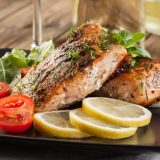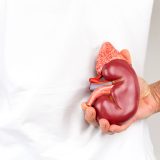

Testosterone is the dominant sex hormone in men. It is responsible for the development of male sexual organs and secondary male sexual characteristics such as: muscle growth and strength, and facial and body hair. Levels of testosterone in the blood gradually elevate through puberty where they peak and remain high until about the age of 30 when levels will start to naturally decline (about 1% per year). When levels of testosterone become abnormally low, a condition called hypogonadism is diagnosed.
In middle-aged men (say 45+) and older, low testosterone levels are often termed male menopause or “andropause.” The symptoms of low testosterone include: erectile dysfunction, reduced sex drive, irritability, depressed mood, sleep disturbances, loss of concentration, diminished muscle mass and strength, and a general loss of interest in work and play.
In addition to the natural effects of aging, low testosterone can be congenital or it can be acquired through illness (mumps), injury (traumatic brain injury), toxic exposure such as prescription drugs and lifestyle factors, including: stress, obesity, metabolic syndrome, diabetes, smoking and excessive alcohol use.
Interestingly, research is indicating that low testosterone may be a risk factor or complication of problems such as obesity, diabetes and cardiovascular disease. And one recent study made a correlation between low testosterone and premature death in men.
So, clearly, Low T should be taken seriously; but the choice to use testosterone replacement therapy should not be made lightly. As with any medicinal intervention, HRT can have negative effects. Testosterone replacement has been associated with gynecomastia (male breast enlargement), testicular shrinkage, sleep apnea, benign prostatic hypertrophy (enlarged prostate), prostate cancer and increased risk of heart attack and stroke. Despite the risks new research published in the Journal of Clinical Endocrinology & Metabolism indicates that testosterone therapy is being prescribed for many individuals who do not meet the clinical guidelines for treatment.
6 Things to Try Before Utilizing the Medical Approach
The good news is there are ways to increase testosterone without the hormone replacement and these steps should probably be tried before resorting to the medical approach:
- Exercise – High intensity interval resistance training (HIIRT) using compound movements will boost testosterone temporarily and will help reduce body fat, which is a contributing factor in testosterone deficiency.
- Eat foods that contain nutrients necessary for testosterone production:
- Lean beef – high in protein, zinc and saturated fats.
- Healthy oils/fats – extra virgin olive oil, coconut oil, avocados, nuts.
- Cruciferous vegetables contain indole-3-carbinol – reduces estrogen/aromatization.
- Allium family – garlic, onions, leeks, etc. Contain quercetin which detoxifies the liver and suppresses estrogen formation.
- Citrus fruits, especially lemons and limes. Contain flavonones, which suppress estrogen production.
- Fermented foods – sauerkraut, kimchi, yogurt, apple cider vinegar. Support internal balance, elimination and estrogen detoxification.
- Use these antioxidant rich herbs in your cooking – oregano, thyme, rosemary, sage, turmeric – all promote liver detoxification. Turmeric (and its active ingredient curcumin) is a powerful anti-inflammatory that promotes apoptosis (suicide) of cancer cells in breast, uterine, ovarian and prostate cancers. It also suppresses NFkb, a cellular enzyme that causes systemic inflammation, and turmeric inhibits neovascularization (the process of a tumor developing new blood supply so it can grow).
- Nutrients – consider supplementing with these nutrients to build your testosterone levels, drug-free:
- Zinc – necessary for testosterone production. Dietary zinc is mainly found in animal sources so vegans should consider supplementing. Omnivores would benefit from supplementation as well due to the depleted nature of the feeds that are used in the meat industry.
- Vitamin D3 – increases testosterone levels. Maintaining adequate levels is difficult without supplementation, especially in winter.
- L-arginine – an amino acid that helps the body eliminate estrogen.
- Acetyl-L-Carnitine – increases testosterone production. Also promotes fat metabolism and muscle growth.
- DHEA – Dehydrepiandrosterone is a naturally occurring steroid hormone in the body. It is a sex hormone precursor and is necessary for production of testosterone and estrogen. It is legally sold in the U.S. as a nutritional supplement.
- Tribulus Terrestris – an herb used in ancient Chinese and Ayurvedic medicine. It promotes muscle growth, increased libido and improved athletic performance. These are all good indicators of testosterone sufficiency. Studies show it can increase testosterone by 50%.
- Cordyceps – a Chinese mushroom used to enhance energy and vitality and increase testosterone.
- Branched Chain Amino Acids – combined with strength-training, BCAA’s have been shown to increase free testosterone levels in the blood.
- Reduce or eliminate – sugar, refined carbohydrates, processed foods, and alcohol. All of these things promote weight gain. Excess fat will soak up the testosterone in your blood and convert it to estradiol (a form of estrogen). If you are overweight and trying to increase your testosterone, use an aromatase inhibiting supplement to prevent this conversion.
- Reduce your stress – prayer, meditation, yoga, tai chi, or vigorous exercise. One or more of these will help to support testosterone levels as well as overall well-being if used regularly.
Obviously, the natural approach takes more thought, time and planning than rubbing a little cream on your thigh twice a day. But, considering the potential negative effects of replacement drugs and the overall health benefits brought on by taking the natural route; it may be worth the effort.




